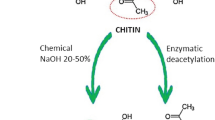Abstract
Intratumoral and local drug delivery strategies have gained momentum recently as a promising modality in cancer therapy. In order to deliver paclitaxel at the tumor site in therapeutically relevant concentrations, chitosan films were fabricated. Paclitaxel could be loaded at 31% wt/wt in films, which were translucent and flexible. Physicochemical characterization of paclitaxel via thermal, spectroscopic, x-ray diffraction, and electron microscopy techniques revealed information on solid-state properties of paclitaxel as well as chitosan in films. While chitosan was in amorphous form, paclitaxel seemed to be present in both amorphous and crystalline forms in film. The polymeric dispersion of paclitaxel in poloxamer formed fibrous structures generating discontinuities in the film matrix, thereby leading to the introduction of perturbations in the packing arrangement of polymer chains. These films released only 10% to 15% of loaded paclitaxel by a burst effect under in vitro testing conditions, with lysozyme having no effect on the release. However, films softened after implantation in mice and lost integrity over time. The implantable delivery system is not only biodegradable but also well tolerated in vivo and hence, biocompatible as revealed by histological studies. The lack of formulation-induced local inflammatory responses of paclitaxel chitosan films suggests a new paradigm for localized chemotherapy based on implantable systems.
Similar content being viewed by others
References
Angelova N, Hunkeler D. Rationalizing the design of polymeric biomaterials.Trends Biotechnol. 1999;17:409–421.
Pillai O, Panchagnula R. Polymers in drug delivery.Curr Opin Chem Biol. 2001;5:447–451.
Pangburn SH, Trescony PV, Heller J. Lysozyme degradation of partially deacetylated chitin, its films and hydrogels.Biomaterials. 1982;3:105–108.
Janes KA, Fresnean MP, Marazuela A, et al. Chitosan nanoparticles as delivery systems for doxorubicin.J Control Release. 2001;73:255–267.
Ruel-Gariepy E, Chenite A, Chaput C, et al. Characterization of thermosensitive chitosan gels for the sustained delivery of drugs.Int J Pharm. 2000;203:89–98.
Muzarelli R, Baldassarre V, Conti F, et al. Biological activity of chitosan: ultra structural study.Biomaterials. 1998;9:247–252.
Senel S, Ikinci G, Kas S, et al. Chitosan films and hydrogels of cholhexidine gluconate for oral mucosal delivery.Int J Pharm. 2000;193:197–203.
Ouchi T, Banba T, Fujimoto M, et al. Synthesis and antitumor activity of chitosan canying 5-fluorouracil.Makromol Chem. 1989;190:1817–1825.
Jameela SR, Jayakrisnan A. Glutaraldehyde cross-linked chitosan microspheres as a long acting biodegradable drug delivery vehicle: studies on the in vitro release of mitoxantrone and in vivo degradation of microspheres in rat muscle.Biomaterials. 1995;16:769–775.
Blanco MD, Gomez C, Olmo R, et al. Chitosan microspheres in PLG films as devices for cytarabine release.Int J Pharm. 2000;202:29–39.
Miwa A, Ishibe A, Nakano M, et al. Development of novel chitosan derivatives as micellar carriers of taxol.Pharm Res. 1998;15:1844–1850.
Ma J, Wang H, He B, et al. A preliminary in vitro study on the fabrication and tissue engineering applications of a novel chitosan bilayer materials as a scaffold of human neofetal dermal fibroblasts.Biomaterials. 2001;22:331–336.
Miyazaki S, Yamaguchi H, Takada M, et al. Pharmaceutical application of biomedical polymers. XXIX. Preliminary study on film dosage form prepared from chitosan for oral drug delivery.Acta Pharm Nord. 1990;2:401–406.
Chandy T, Sharma CP. Biodegradable chitosan matrix for the controlled release of steroids.Biomater Artif Cells Immobilization Biotechnol. 1991;19:745–760.
Lesser GJ, Grossman SA, Eller S, et al. The distribution of systemically administered [3H]-paclitaxel in rats: a quantitative autoradiographic study.Cancer Chemother Pharmacol. 1995;37:173–178.
Brem H, Gabikian P. Biodegradable polymer implants to treat brain tumors.J Control Release. 2001;74:63–67.
Ringel I, Horwitz SB. Taxol is converted to 7-epitaxol, a biologically active isomer, in cell culture medium.J Pharmacol Exp Ther. 1987;242:692–698.
Horisawa E, Hirota T, Kawajoe S, et al. Prolonged anti-inflammatory action of D,L-lactide/glycolide copolymer nanospheres containing betamethasone sodium phosphate for intra-articular delivery system in antigen-induced arthritic rabbit.Pharm Res. 2002;19:403–410.
Liggins RT, Hunter WL, Burt HM. Solid-state characterization of paclitaxel.J Pharm Sci. 1997;86:1458–1463.
Kemp W. Infrared spectroscopy. In:Organic Spectroscopy. London, UK: Macmillan Press; 1996:19–100.
Ratner BD, Kwok C. Characterization of delivery systems surface analysis and controlled release systems. In: Mathiowitz E, eds.Encyclopedia of Controlled Drug Delivery New York, NY: John Wiley and Sons; 1999:261–269.
Chenite A, Chaput C, Wang D, et al. Novel injectable neutral solutions of chitosan form biodegradable gels in situ.Biomaterials. 2000;21:2155–2161.
Grit M, Crommelin DJ. Chemical stability of liposomes: implications for their physical stability.Chem Phys Lipids. 1993;64:3–18.
Zuidam NJ, Crommelin DJ. Chemical hydrolysis of phospholipids.J Pharm Sci. 1995;84:1113–1119.
Kofuji K, Shibata K, Murata Y, et al. Preparation and drug retention of biodegradable chitosan gel beads.Chem Pharm Bull (Tokyo). 1999;47:1494–1496.
Schwendeman SP, Costantino HR, Gupta RK, et al. Strategies for stabilising tetanus toxoid towards the development of a single-dose tetanus vaccine.Dev Biol Stand. 1996;87:293–306.
Tomihata K, Ikada Y. In vitro and in vivo degradation of films of chitin and its deacetylated derivatives.Biomaterials. 1997;18:567–575.
Martin A. Polymer science. In: Physical Pharmacy:Physical Chemical Principles in the Pharmaceutical Sciences. Baltimore, MD: Waverly International; 1994:556–594.
Ford JL, Timmins P.Pharmaceutical Thermal Analysis: Techniques and Applications. Chichester, UK: Ellis Horwood; 1989:180–200.
Nunthanid J, Puttipipatkhachorn S, Yamamoto K, et al. Physical properties and molecular behavior of chitosan films.Drug Dev Ind Pharm. 2001;27:143–157.
Puttipipatkhachorn S, Nunthanid J, Yamamoto K, et al. Drug physical state and drug-polymer interaction on drug release from chitosan matrix films.J Control Release. 2001;75:143–153.
Author information
Authors and Affiliations
Corresponding author
Additional information
Published: October 11, 2004.
Rights and permissions
About this article
Cite this article
Dhanikula, A.B., Panchagnula, R. Development and characterization of biodegradable chitosan films for local delivery of paclitaxel. AAPS J 6, 27 (2004). https://doi.org/10.1208/aapsj060327
Received:
Accepted:
Published:
DOI: https://doi.org/10.1208/aapsj060327




